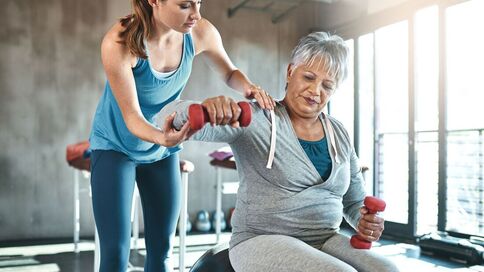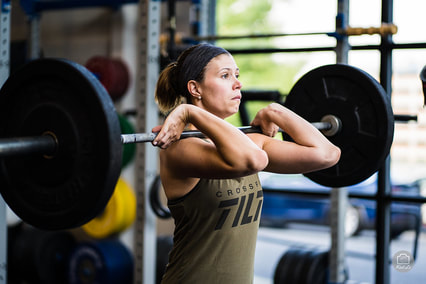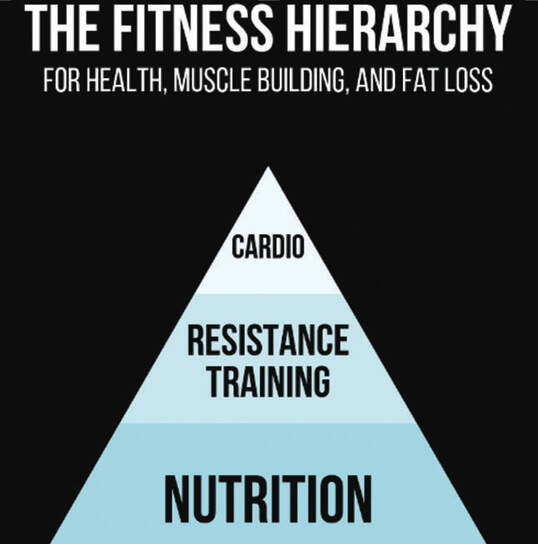 Welcome, ladies! Today, we're diving deep into a common obstacle many women face on their weight loss journey: being under muscled. You might be diligent with your diet, logging hours on the treadmill, yet still struggle to shed those stubborn pounds. Here's the scoop: it's time to shift our focus from just losing weight to building muscle. Let's explore why your muscle mass matters and how it impacts your weight loss goals. Understanding the Problem: So, what exactly does it mean to be "under muscled"? In simple terms, it's having inadequate muscle mass relative to your body composition. As we age, especially between the ages of 30-50, our muscle mass naturally declines due to factors like hormonal changes, decreased activity levels, and even dietary habits. This decline in muscle mass not only affects our strength and mobility but also plays a crucial role in our ability to lose weight effectively. The Muscle-Fat Connection: Here's the kicker: muscle is a metabolically active tissue, meaning it burns calories even at rest. The more muscle mass you have, the higher your basal metabolic rate (BMR), which translates to more calories burned throughout the day. On the flip side, excess fat tissue does little in terms of calorie expenditure. So, if you're carrying more fat than muscle, your body becomes less efficient at burning calories, making weight loss an uphill battle. The Benefits of Building Muscle: 1. Increased Metabolism: By building muscle through resistance training, you can rev up your metabolism, making it easier to create the calorie deficit necessary for weight loss. 2. Improved Body Composition: Building muscle while losing fat leads to a leaner, more toned physique, rather than simply becoming smaller in size. 3. Enhanced Strength and Functionality: Strong muscles not only support you during workouts but also in daily activities, promoting better posture, balance, and overall vitality. How to Build Muscle and Lose Weight: 1. Strength Training: Incorporate resistance training exercises into your routine at least 2-3 times per week. Focus on compound movements like squats, deadlifts, lunges, and rows to target multiple muscle groups simultaneously. 2. Progressive Overload: Continuously challenge your muscles by gradually increasing the weight, reps, or intensity of your workouts over time. This stimulates muscle growth and prevents plateaus. 3. Balanced Nutrition: Ensure you're consuming enough protein to support muscle repair and growth, while also maintaining a slight calorie deficit to facilitate fat loss. Opt for nutrient-dense foods like lean meats, fish, eggs, legumes, and plenty of fruits and vegetables. 4. Rest and Recovery: Don't overlook the importance of rest days and quality sleep. Muscles need time to repair and grow, so prioritize recovery to avoid burnout and injury. Conclusion: Ladies, if you've been struggling to lose weight despite your best efforts, it's time to shift your focus to building muscle. Remember, it's not just about the number on the scale, but rather achieving a healthy balance of muscle and fat for long-term success. By incorporating strength training into your routine and prioritizing muscle growth, you'll not only transform your physique but also supercharge your metabolism and reclaim your confidence. Here's to becoming strong, empowered women who can conquer any challenge that comes our way! So, are you ready to say goodbye to being under muscled and hello to a stronger, leaner you? Let's do this together! Coach Kayli
0 Comments
Blog Post By Kayli Montoya-HustonNASM Certified Personal Trainer & NCI Certified Nutrition Coach L1 and Mindset Coach Embarking on a weight loss journey can be challenging, especially when you're committed to shedding those stubborn pounds but see minimal results. If you're wondering why your body fat isn't budging, you're not alone. In this blog post, we'll explore the top 10 reasons that might be hindering your fat loss progress and provide practical solutions to overcome these obstacles.
Inadequate Caloric Deficit:
Conclusion: Identifying and addressing these roadblocks can pave the way for successful fat loss. Remember, patience and consistency are key. Consult with a qualified nutrition coach or personal trainer to personalize your approach and maximize your results. Your fitness journey is unique, and understanding these reasons can help you overcome obstacles and achieve your body fat loss goals. Welcome to 2024!
As we dive into the new year, let's focus on what really matters for fat-loss. I'm not about quick fixes or fads. It's all about practical steps you can actually stick to. This is my 9th January working in fitness, and I'm often inspired and rejuvenated by the new year too. Many people bash "resolutions," making it feel vulnerable to admit having big health goals for the new year. But you aren't alone. There are plenty of others watching this who want to improve how they look, move, and feel. The number one thing I hear from people at the beginning of each new year is their desire to lose weight, closely followed by wishes to eat "better" and "exercise more." Let’s tackle two out of these three: losing weight and eating better. These are the two things (besides maybe better sleep) that will help you feel better. So here is Tip #1 of the 10 no-nonsense strategies to help you lose fat more easily this year.
Stay strong, Coach Kayli!  First, what is Osteoporosis? Osteoporosis is a condition characterized by weak and fragile bones that are liable to fracture. Normal, strong and healthy bones contain large amounts of minerals, which make them strong. The amount of these bone minerals within our bones is referred to as our bone mineral density (BMD). Our bones are in a constant state of adaptation, with bone being broken down and remodeled and rebuilt continuously. When bones break down faster than they rebuild, our bone mineral density decreases. Our BMD is highest when we are aged in our 20s, and then as we get older our BMD gradually declines. If this loss of minerals from the bone is excessive, our BMD will become very low, and we will develop osteoporosis. Osteoporosis is a common cause of fractures in older Americans, especially women. In women, the greatest rate of bone loss occurs in the years immediately following menopause. How can resistance training help? Resistance training to prevent osteoporosis: Regular weight-bearing exercise in children and teenagers helps produce strong bones; in adults it helps to maintain bone mass; after menopause it can be part of an overall treatment plan that aims to slow the rate of bone loss; and in adults over 65 years physical activity can be used to both reduce the rate of bone loss and avoid injury to bones by improving muscle strength and balance. The strength of your bones also determines the type of exercise that is appropriate and safe for your bones. Certain types of resistance training have been shown to minimize the loss in BMD, and in some research studies to even produce an increase in BMD. This is beneficial for both the prevention and the treatment of osteoporosis. If you already have osteoporosis or other medical conditions and have not exercised regularly, speak to a professional about designing an exercise program that is suitable for you. The best types of exercise for decreasing the risk of developing osteoporosis are:
Exercises such as swimming and cycling help improve cardiovascular fitness and build muscle strength, but are not as effective at preventing osteoporosis as weight-bearing exercise. So if you are already swimming or cycling regularly but not doing any other forms of exercise, you should consider adding weight-bearing and/or resistance exercise to your weekly routine. Always check with your doctor before starting a new exercise program. Resistance training helps improve your bone health by putting strain on the bones, which helps make them stronger. As your body adapts you will need to increase the resistance to continue to improve bone strength. There is some evidence indicating that progressing to heavier resistances is most effective in preventing the loss of an increasing BMD. Doing a program of resistance exercises 2-3 times per week has been shown to help maintain and even increase bone mineral density in women who have gone through menopause. Resistance training also helps to build up and maintain muscle mass, which helps reduce the risk of falls. Resistance Training For All Since the prevention of osteoporosis is a far better strategy than trying to reverse it, all adults should undertake regular weight-bearing and/or resistance training regardless of their age. In young people this will help to increase their BMD to higher peak levels, which will then reduce the risk of it declining to osteoporotic levels later in life. Continuing with this exercise throughout your life will minimize the decline in BMD that occurs with age and further reduce the risk of osteoporosis in old age. Want help? Not sure where to start or what program to run? That’s where I come in! Let me help you get started in your fitness journey with a safe, effective resistance training program tailored to your body and your goals. If having someone in your corner every step of the way in training, nutrition and mindset sounds like something you would greatly benefit from then take 2 minutes and click the link below to fill out an application for a 15 minute coaching call with me. Where we will discuss your goals in great detail and find out if we would make a great fit to work together.  Studies have shown that resistance training has many positive effects on physical health, but did you know that resistance training is also a good tool to use for mental health as well? Studies have shown that resistance training has had positive benefits on many mental health issues. Of the trials conducted, participants have seen reductions in anxiety symptoms, reduction in pain intensity among patients with lower back pain, osteoarthritis and fibromyalgia, improvements in cognition among older adults, improvements in sleep quality among depressed older adults, reductions in symptoms of depression among patients with diagnosed depression and fibromyalgia, reductions in fatigue symptoms, and improvements in self esteem. Many of these things all seem connected. For example, weight training helps a patient sleep better which is going to lower ghrelin (the body’s hunger hormone). In turn, potentially causing them to reduce unnecessary snacking to help them lose a few pounds which could cause an improvement in self esteem. All of these things are interconnected in various different ways. Aside from all the mental health positives, resistance training also seems to have some built factors that help your overall approach to life a bit differently. Other than peace of mind and some self confidence, resistance training seems to also act as a wise janitor of life coming to teach you valuable life lessons and skills. The first, stronger muscles make daily tasks easier. If your everyday tasks can be performed with less pain and more ease, the stress of completing them will drop. Plus, the confidence boost of feeling stronger and being more self reliant isn’t a bad side effect either. Unless of course you are a husband that takes pride in opening the pickle jar! Second, let go with care. Hear me out! So when you lift weights, it’s important to perform both the eccentric and concentric motions with care and purpose in order to get the most out of the movement. It is simply key to proper performance. You should always use as much care to put down the weight as you did to pick it up. In life, when we are exhausted or overwhelmed by something, we often just cast it aside thoughtlessly and be done with it. Just give up. This will rarely serve you well. Ah, yes, next up, the value of rest. When I design programs, I assign specific rest periods between sets. There is a reason for this. You need to give your central nervous system a break and allow it to regroup before jumping right back into a lift. This is often why rest periods are longer on programs with heavy compound lifts. They are more taxing to your CNS than lower weight accessory movements. So, how does this relate to life you ask . . . well, just like weight training, when you pause in other areas of your life instead of rushing through tasks as quickly as possible, you’ll find that you are more productive and more positive results will emerge. Often you just need to find the right balance between rest and work. This one is another favorite of mine! The power of breath! Yes, breath. I know breathing is essential to life, but that’s not where I’m going with that. Those of you that have trained with me in person have probably heard me instruct you on how to breathe when you are lifting weights. It is very important for effective weight lifting to breathe properly. Generally speaking, you should be inhaling during the concentric and exhaling during the eccentric. This allows you to get maximal force in your lift. Similar effects can be seen during trying times in life. When you are feeling pressure or anxious, take a deep breath. Taking a few deep breaths will help you speak up, calm down and keep your cool much easier. Last but not least, to build strong muscles, you must break them. Yep, that’s right. When you lift weights, you tear your muscles. That’s the point, because they come back bigger and stronger. (insert Hulk growl) Think about it. You experience muscle growth after you tear the muscles. So basically to make a muscle stronger you have to injure it. It’s through the process of repair it gets stronger. Think about the hardest moments in your life. Think about how much they hurt. Did you get through it? Are you stronger now because of it? I would bet that every challenge you’ve encountered in your life has made you stronger and that’s because with pain comes growth. That growth can be emotional too. After all the heart is a muscle too. If I haven’t already spoken enough about the benefits of weight training, here’s just some more science backed evidence to show that resistance training literally can benefit everyone, in some way. You don’t have to be a bodybuilder or a powerlifter that’s training for a show to see benefits. Everyone has something to gain. If you’re ready to make a change in your life, but don’t know where to start, apply for a free coaching call. I’d love to be a part of your journey to a better life.  I want to teach you where you should put the majority of your focus on if you're wanting to lose fat, build some muscle and just care about your overall health. This Hierarchy was explained very well to me by my Coach Jeremiah Bair. I would love to share with you what I have learned from him. To the right, you will see The Fitness Hierarchy Ranked from most-least important:
Most people are surprised by this, expecting cardio to be the number one focus, followed by stepping into the gym a few times, and dieting hard for a couple weeks every January. Now why doesn’t this work? Nutrition In order to lose fat we must eat fewer calories than we burn in a day. It is impossible to erase a poor diet with exercise. Why? Because you just don’t burn very many calories when you exercise (about 5% of your total daily calorie burn comes from exercise.) Calories in < Calories out = Fat Loss. This is called Energy Balance Main takeaway here is watching your diet to control the “calories in” side of the energy balance equation is much easier than trying to lose fat by ramping up the “calories out” side of the equation. This is why Nutrition is the most important factor to pay attention to. Resistance Training Lifting weights actually burns fewer calories than cardio. But, resistance training has many more benefits for you than cardio:
It’s rewarding It’s a huge psychological boost Find a plan you can see yourself sticking to for a really long time. Cardio Cardio is still helpful. We just don’t want to put the majority of our focus in it. Cardio has obvious cardiovascular health benefits-it’s good for your heart. Cardio has carryover to your resistance training. It allows you to recover quicker - both between sets and between training sessions. Now the biggest issue with cardio is that your body adapts very quickly to it. When you adapt to something, you become more efficient at it. Becoming efficient means you’re burning less calories. So take this for example: If you were to run 1 mile you might burn 100 calories. As the adaptation occurs, the calorie burn decreases. So after running a mile every day this week and burning a 100 calories each time you may end up only burning 90 calories the next week, and then 80 the next. The only way to keep burning 100 calories is to increase the distance and/or time spent running. The problem is - who has the time or desire in our busy lives to keep adding miles forever? Conclusion:
-Coach Kayli Questions? Email me: [email protected] |
AuthorKayli is a certified personal trainer and online coach that specializes in fitness, wellness, nutrition, mindset, mobility and everything in between. Categories
All
Archives
June 2024
|
Call Us 620-757-9146
Home | About Us | Personal Training | Online Nutrition and Fitness Coaching | Custom Training Plans | Breakfast | Entrees | Dressings | Snacks | Blog
Phoenix Rising Podcast | Product Recommendations | Contact Me
Phoenix Rising Podcast | Product Recommendations | Contact Me
Copyright 2024 Kayli Montoya Fitness


